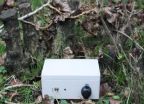(Press-News.org) Once the snow melts, Canada's bee population will be back in business -- pollinating, making honey and keeping busy doing bee things. For at least two urban bee species, that means making nests out of plastic waste.
A new study by a University of Guelph graduate and a U of G scientist reveals that some bees use bits of plastic bags and plastic building materials to construct their nests. The research was published recently in the journal Ecosphere.
It's an important discovery because it shows bees' resourcefulness and flexibility in adapting to a human-dominated world, says lead author Scott MacIvor, a doctoral student at York University and a 2008 U of G graduate.
"Plastic waste pervades the global landscape," said MacIvor. Although researchers have shown adverse impacts of the material on species and the ecosystem, few scientists have observed insects adapting to a plastic-rich environment, he said.
"We found two solitary bee species using plastic in place of natural nest building materials, which suggests innovative use of common urban materials.
Figuring out that the bees were using plastics in place of natural materials took some detective work by U of G's Andrew Moore, supervisor of analytical microscopy at Laboratory Services.
Moore analyzed a grey "goo" that MacIvor discovered in the nests of one kind of bee, Megachile campanulae, which uses plant resins to build its nests,
"Scott thought it might be chewing gum originally," Moore said. His team uses a scanning electron microscope to take highly detailed pictures of items, x-ray microanalysis to determine the elements in the sample and infrared microscopy to identify polymers. They can distinguish the finest detail on the surface of an animal hair.
Turns out that M. campanulae was occasionally replacing plant resins with polyurethane-based exterior building sealant, such as caulking, in its brood cells--created in a nest to rear larva.
The researchers also discovered another kind of bee, Megachile rotundata, an alfalfa leafcutter, was using pieces of polyethylene-based plastic bags to construct its brood cells. The glossy plastic replaced almost one-quarter of the cut leaves normally used to build each cell.
Markings showed that the bees chewed the plastic differently than they did leaves, suggesting that the insects had not incidentally collected plastic. Nor were leaves hard to find for the bees in the study.
"The plastic materials had been gathered by the bees, and then worked – chewed up and spit out like gum – to form something new that they could use," Moore said.
In both cases, larvae successfully developed from the plastic-lined nests. In fact, the bees emerged parasite-free, suggesting plastic nests may physically impede parasites, the study said.
The nests containing plastic were among more than 200 artificial nest boxes monitored by MacIvor as part of a large-scale investigation of the ecology of urban bees and wasps, a project involving numerous citizen scientists.
The nest boxes are located in Toronto and the surrounding region in backyards, community gardens and parks and on green roofs. They are used by a variety of bee species.
"The novel use of plastics in the nests of bees could reflect the ecologically adaptive traits necessary for survival in an increasingly human-dominated environment," MacIvor said.
INFORMATION: END
Urban bees using plastic to build hives
2014-02-11
ELSE PRESS RELEASES FROM THIS DATE:
MIT robot may accelerate trials for stroke medications
2014-02-11
The development of drugs to treat acute stroke or aid in stroke recovery is a multibillion-dollar endeavor that only rarely pays off in the form of government-approved pharmaceuticals. Drug companies spend years testing safety and dosage in the clinic, only to find in Phase III clinical efficacy trials that target compounds have little to no benefit. The lengthy process is inefficient, costly, and discouraging, says Hermano Igo Krebs, a principal research scientist in MIT's Department of Mechanical Engineering.
"Most drug studies failed and some companies are getting ...
First observation of a human HAT, key proteins in numerous pathologies
2014-02-11
The researcher Manuel Palacín, head of the Heterogenic and Multigenic Diseases lab at the Institute for Research in Biomedicine (IRB), in Barcelona, is among the world's experts in HATs (heteromeric amino acid transporters).
In humans, there are eight HAT molecules. These are associated, for example, with the following: rare diseases called aminoacidurias, such as lysinuric protein intolerance and cystinuria; the development of infections caused by the Kaposi sarcoma virus; various types of cancer; and relapse in cocaine use. HATs are, as the name implies, amino acid ...
Rare cancers: the challenge of accurate diagnosis -- press release
2014-02-11
Brussels, Belgium, 11 February 2014 -- Inaccurate diagnosis is a major obstacle for the proper treatment of patients with rare cancers. A Consensus on Improving the Pathologic Diagnosis of Rare Cancers was presented today by RARE CANCERS EUROPE, together with the European Society for Medical Oncology (ESMO) and the European Society of Pathology (ESP) in Brussels. The recommendations aim to help rare cancer patients get a timely and accurate diagnosis.
The statement is the result of a two-day workshop, where the particular challenges for each type of rare cancer(1) were ...
Could statins be used to fight a deadly viral infection?
2014-02-11
Two Perelman School of Medicine microbiologists may have found a way to use statins, the well-known blockbuster cholesterol-lowering drugs, to fight the hantavirus, a mysterious and lethal microorganism that appeared suddenly in the US southwest over 20 years ago. That first outbreak led to the deaths of more than a dozen people, most of them in their prime. The last reported outbreak happened in Yellowstone Park in 2012.
Only about 30 known human cases of hantavirus are reported in the US each year. The respiratory syndrome caused by a hantavirus infection comes from ...
Hacking the environment: bringing biodiversity hardware into the open
2014-02-11
New technologies are changing the way we collect biodiversity data. Data that once required taking expensive, bulky and fragile equipment on field trips can now be collected on cheap, compact and robust devices. In a recent paper in the Biodiversity Data Journal the construction of an environmental data-logger using the Arduino platform is described. It is hoped that this work will encourage the adoption of new data collection technologies by biodiversity scientists and foster new collaborations with both electronics hobbyists and electronics engineers who have an interest ...
Exon skipping prevents formation of toxic protein fragments in Huntington's disease
2014-02-11
New Rochelle, NY, February 11, 2014—An innovative therapeutic strategy for reducing the levels of toxic protein fragments associated with Huntington's disease uses a new approach called exon skipping to remove the disease-causing component of the essential protein, huntingtin. Proof of concept using antisense oligonucleotides to "skip over" the specific exon in a mouse model of Huntington's disease is reported in an article in Nucleic Acid Therapeutics, a peer-reviewed journal from Mary Ann Liebert, Inc., publishers. The article, part of a special focus issue on exon skipping, ...
Excess weight linked to brain changes that may relate to memory, emotions, and appetite
2014-02-11
Being overweight appears related to reduced levels of a molecule that reflects brain cell health in the hippocampus, a part of the brain involved in memory, learning, and emotions, and likely also involved in appetite control, according to a study performed by researchers at SUNY Downstate Medical Center and other institutions. The results of the study were published in Neuroimage: Clinical.
Jeremy D. Coplan, MD, professor of psychiatry at SUNY Downstate, led a multicenter team that visualized the molecule, N-acetyl-aspartate (NAA), using magnetic resonance spectroscopy, ...
RI Hospital: Cognitive behavioral therapy benefits patients with body dysmorphic disorder
2014-02-11
PROVIDENCE, R.I. – In a recent study, researchers at Rhode Island Hospital found significant benefits of cognitive behavioral therapy as a treatment modality for patients with Body Dysmorphic Disorder (BDD). BDD is a common, often severe, and under-recognized body image disorder that affects an estimated 1.7 percent to 2.4 percent of the population. This study demonstrated significant improvement in patients' BDD symptoms and level of disability, as well as high levels of patient satisfaction with the treatment. The study is published online in advance of print in the journal ...
Source of 'moon curse' revealed by eclipse
2014-02-11
Strange events have long been linked to nights of a full moon, though careful scrutiny dispels any association. So, when signals bounced off the lunar surface returned surprisingly faint echoes on full moon nights, scientists sought an explanation in reason rather than superstition. Still, the most compelling evidence arrived during another event that once evoked irrational fears—on a night when Earth's shadow eclipsed the full moon.
Tom Murphy, a physicist at UC San Diego, is among the scientists who have aimed laser beams at suitcase-sized reflectors placed on the moon ...
Study: Resilience in parents of children undergoing stem cell transplant
2014-02-11
A child's illness can challenge a parent's wellbeing. However, a study recently published in the journal Biology of Blood and Marrow Transplantation shows that in the case of a child's stem cell transplant, parents feel increased distress at the time of the procedure, but eventually recover to normal levels of adjustment.
"Across all study groups, what we basically showed is that parents are resilient. Overall, parents get better over time," says Jennifer Lindwall, PhD, assistant professor of psychiatry at the CU School of Medicine, teaching partner of the University ...



